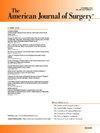胃束带术后复查Roux-en- y胃旁路术,无论Roux肢体长度如何,均可导致持续且显著的额外体重减轻
IF 2.7
3区 医学
Q1 SURGERY
引用次数: 0
摘要
本研究的目的是比较可调节胃束带(LAGB)后行超长肢RYGB (VVLL-RYGB)和近端RYGB (PRYGB)患者的预后。方法对2010 - 2016年在某体重参考中心接受LAGB向RYGB转化的所有患者进行分析。结果66例患者(女性80%,平均年龄44.5±9岁,修正前BMI 40.2±7.4 kg/m2)从LAGB转换为VVLL-RYGB, 26例患者(女性88%,平均年龄46.9±7.6岁,修正前BMI 37.2±5.3 kg/m2)转换为PRYGB。ΔBMI转换后5年VVLL-RYGB为8.2±6.1 kg/m2,而PRYGB为6.7±5.1 kg/m2 (p = 0.35)。两组长期发病率无显著差异。VVLL-RYGB术后10例(15.1%),PRYGB术后8例(30.8%)进一步复查(p = 0.136)。结论vvll - rygb和PRYGB在LAGB后是安全的,并且在5年后两种方法之间的BMI下降无差异,可导致显著和持续的额外体重减轻。本文章由计算机程序翻译,如有差异,请以英文原文为准。
Revisional Roux-en-Y gastric bypass after gastric banding leads to sustainable and significant additional weight loss regardless of Roux limb length
Introduction
The aim of this study is to compare the outcomes between patients undergoing very-very long limb RYGB (VVLL-RYGB) and proximal RYGB (PRYGB) after adjustable gastric banding (LAGB).
Methods
All patients undergoing conversion from LAGB to RYGB in a bariatric reference center between 2010 and 2016 were analyzed.
Results
Sixty-six patients (80 % female, mean age 44.5 ± 9 years, pre-revisional BMI 40.2 ± 7.4 kg/m2) underwent conversion from LAGB to VVLL-RYGB, and 26 patients (88 % female, mean age 46.9 ± 7.6 years, pre-revisional BMI 37.2 ± 5.3 kg/m2) to PRYGB. ΔBMI 5 years after conversion was 8.2 ± 6.1 kg/m2 in VVLL-RYGB compared to 6.7 ± 5.1 kg/m2 in PRYGB (p = 0.35). There was no significant difference in long-term morbidity. Further revisional procedures after VVLL-RYGB occurred in 10 (15.1 %) and 8 (30.8 %) after PRYGB (p = 0.136).
Conclusion
VVLL-RYGB and PRYGB after LAGB are safe and lead to significant and sustainable additional weight loss without difference in BMI loss between the procedures after 5 years.
求助全文
通过发布文献求助,成功后即可免费获取论文全文。
去求助
来源期刊
CiteScore
5.00
自引率
6.70%
发文量
570
审稿时长
56 days
期刊介绍:
The American Journal of Surgery® is a peer-reviewed journal designed for the general surgeon who performs abdominal, cancer, vascular, head and neck, breast, colorectal, and other forms of surgery. AJS is the official journal of 7 major surgical societies* and publishes their official papers as well as independently submitted clinical studies, editorials, reviews, brief reports, correspondence and book reviews.

 求助内容:
求助内容: 应助结果提醒方式:
应助结果提醒方式:


